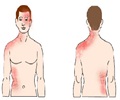A study performed on mice has revealed that by combining a chemotherapy drug with a herpes virus genetically modified to express a drug enhancing enzyme
A study performed on mice has revealed that combining a chemotherapy drug with a herpes virus genetically modified to express a drug-enhancing enzyme, could reduce the size of highly malignant human sarcoma effectively and safely.
According to the researchers, the new finding may add to the growing arsenal of so called oncolytic viruses under development as novel cancer treatments, especially for difficult, inoperable tumours."Our study shows the chemotherapy drug cyclophosphamide (CPA) enhances the anti-tumor effectiveness of the oncolytic virus rRp450 in mice carrying aggressive human sarcoma, resulting in significant tumor shrinkage," said Timothy P. Cripe, M.D., Ph.D., a physician and researcher at Cincinnati Children’s Hospital Medical Center and the study’s corresponding author.
"Just as important is the fact that the combination of rRp450 and CPA appears to be well tolerated, because non-cancer bearing mice treated with the therapy survive long term. It will take some time to continue developing this approach before its potential to be tested in clinical trials, but our results are encouraging and warrant further study," he added.
New treatment options are desperately needed for sarcomas, which occur in soft and connective tissues like bone, cartilage, muscle and blood vessels. In most sarcomas that metastasize - or spread to other parts of the body - less than 30 percent of the patients are curable, Dr. Cripe said.
Chemotherapy combined with surgery and radiation has advanced the treatment of these cancers, but these therapies have limitations. In childhood sarcomas that respond well to chemotherapy but metastasize, less than half of the children who undergo intense, high-dose therapies survive five years from diagnosis. Another challenge is adult sarcomas, which are generally resistant to chemotherapy and radiation.
Dr. Cripe’s research team injected sarcoma tumors in mice with rRp450, in which a normally occurring gene was deleted and replaced with a gene that encodes an enzyme to activate chemotherapy drugs called oxazophosphorines, including cyclophosphamide (CPA). Previous studies have reported the rRp450 virus kills cancer cells by causing their cell membranes to erupt, and that the virus helps the anti-tumor effects of CPA.
Advertisement
The investigators also confirmed the anti-tumor effect of rRp450 treatment alone in mouse models of human cancers rhabdomyosarcoma and neuroblastoma, where they observed significant tumor shrinkage in 13 of 13 injected tumors. Treatment with CPA alone in these models showed limited anti-tumor effectiveness. In a control group of tumor-carrying mice treated with a placebo, all died within 10 days of injection.
Advertisement
The rRp450 virus is different because it retains both copies of the virulence gene but is attenuated by deletion of a different gene. Earlier preclinical studies showed that deleting just the single gene increases rRp450’s ability to degrade cancer cells, but until the current study little had been known about whether a virus with a single-gene mutation would retain neural toxicity to the recipient.
Dr. Cripe and his colleagues addressed the neural toxicity question in part by injecting normal human liver, skin and nerve sheath cells grown in the laboratory with the rRp450 virus and with the normal wild-type HSV-1 virus. Over a 72-hour period, researchers noted a robust replication of the wild-type HSV-1 in these cells, but in cells injected with rRp450, the replication rate was inhibited 10,000 fold with no signs of productive virus infection.
Researchers also tested wild-type HSV-1 in mice by intravenous and intracerebral (brain) injection, comparing those results to mice injected initially with rRp450 and with CPA 24 hours later. Mice getting the wild-type virus suffered from high infection rates, abnormal gait and in some cases death. In contrast, mice receiving a combination of rRp450/CPA tolerated the treatment well with no significant clinical effects on their blood counts or chemistries.
The researchers did note that tissue samples tested during the study retained some viral genetic material, notably DNA fragments, although there were no signs of active disease. Because mice received combined rRp450/CPA only once during the toxicity part of the study, safety tests based on repeated dosing are still needed, and would be necessary to support a multi-dose clinical trial, the researchers said.
"Based on these findings and other preclinical studies, we expect oncolytic viral therapy will be one additional treatment modality available in the future for oncologists," Dr. Cripe said.
The study is published in the journal Molecular Therapy.
Source-ANI
KAV/L











